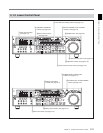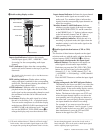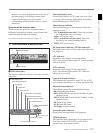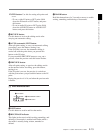
Chapter 2 Location and Function of Parts
2-6 Chapter 2 Location and Function of Parts
2-1 Control Panels
Note
Before selecting signals from two input channels
for recording in one recorder channel, check to be
sure that the emphasis settings (ON or OFF) of the
two input channels are the same. Recording and
playback of mixed signals cannot be carried out
correctly if the emphasis settings are different.
For audio tracks with emphasis on, the EMPH
indicator in the audio setting display section
lights.
Monitor signal selection mode (the input signal
indicator and the MIX indicator do not flash):
The buttons in the upper and lower rows select
tracks to be output to the MONITOR OUTPUT L
and R connectors on the connector panel or the
PHONES jack on the upper control panel. The
buttons in the upper row (L row) select tracks for
output to the MONITOR OUTPUT L connector,
and the buttons on the lower row (R row) select
tracks for output to the MONITOR OUTPUT R
connector. You can obtain the mixed output of
multiple tracks by simultaneously pressing
multiple buttons in the upper or lower rows. For
example, simultaneously press the CH1, CH2, and
CH3 buttons in the upper row to mix the signals of
audio tracks 1, 2, and 3 for output to the
MONITOR OUTPUT L connector.
To monitor channels 5 to 8 in MPEG IMX
playback, press the CUE button to switch between
CH1 to CH4 and CH5 to CH8, and then select the
desired channels.
5 REC (recording) controls
These individually adjust the recording levels on
channels 1 to 4 and cue audio.
To set the recording level, put the unit into E-E mode,
press to protrude the control knobs and adjust the level
while watching the level meters.
When the control knobs are pushed in, the recording
levels return to the preset levels and cannot be
adjusted.
For details about selecting the E-E mode, see the
description of the REC button in the tape transport control
section (see page 2-10) and function menu HOME page (see
page 11-3).
6 PB (playback) controls
These adjust individually the playback levels on
channels 1 to 4 and cue audio.
During playback, press to protrude the control knobs
and adjust the level while monitoring the audio level
indication on the level meters in the audio setting
display section.
When the control knobs are pushed in, the playback
levels return to the preset levels, and cannot be
adjusted.
On how to adjust the output levels of audio channel 5 to 8
during IMX tape playback, see the description of setup menu
item 826 (page 12-29)
2 CHANNEL CONDITION indicator
A three-color indicator shows the state of the playback
signal.
Green: The state of the playback signal is good.
Yellow: The playback signal is somewhat
deteriorated, but playback is possible.
Red: The playback signal is deteriorated.
When this indicator remains on, head cleaning or
an internal inspection is necessary.
3 Menu control buttons
These buttons are used for function menu (see the
following section “Overview of the function menu”)
and setup menu (see Chapter 12) operations. The page
buttons (V, v, and HOME) select menu pages, and the
function buttons (F1 to F6) make function settings.
V: Selects the next page in the order HOME t 1 t
2 t 3 t 4 t 5 t HOME.
v: Selects the next page in the order HOME t 5 t
4 t 3 t 2 t 1 t HOME.
When there are setup menu definitions on page 6,
page 6 is displayed between page 5 and the HOME
page.
HOME: Selects the function menu HOME page.
When at least one user-defined function key is set
in the HOME2 page, pressing the HOME button
toggles the menu page display between HOME
and HOME2.
F1 to F6: Make settings for the items displayed in the
upper line of the menu display (the menu item
display line). Pressing one of these buttons
changes the setting for the corresponding item and
displays the setting in the lower line of the menu
display.


















